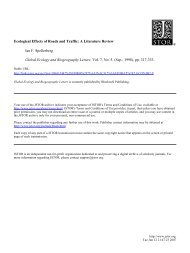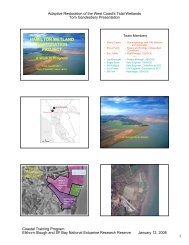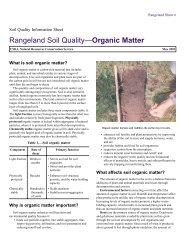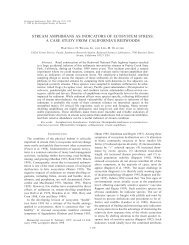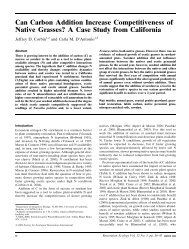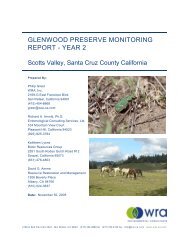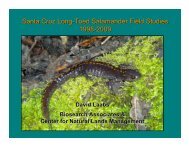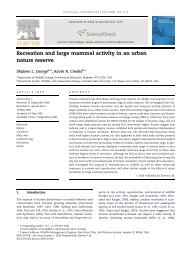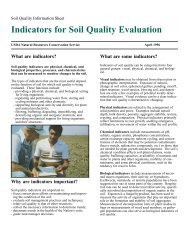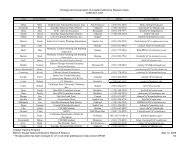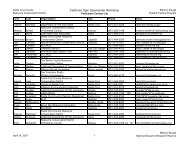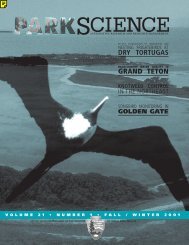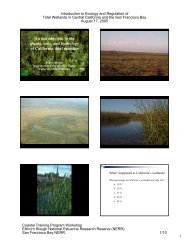BREEDING <strong>BIRD</strong> CENSUS: 2008Spotted Towhee, 10.5 (33); Bewick's Wren, 10.0 (31;1FL); California Quail, 9.5 (30); Anna's Hummingbird,8.0 (25); Lesser Goldfinch, 7.0 (22; 2FL); Bushtit, 5.0(16; 1N); Black-headed Grosbeak, 5.0; House Finch,4.0 (13; 1FL); California Thrasher, 3.5 (11); CommonYellowthroat, 3.0 (9); Hooded Oriole, 3.0 (1FL);Nuttall's Woodpecker, 2.5; Mourning Dove, 2.0;Northern Flicker, 2.0; Western Scrub-Jay, 2.0 (2FL);Black-chinned Hummingbird, 1.0; DownyWoodpecker, 1.0 (1FL); Black Phoebe, 1.0 (2N); HouseWren, 1.0; Yellow Warbler, 1.0; American Goldfinch,1.0; Cooper's Hawk, 0.5; Red-tailed Hawk, 0.5 (1FL);Least Bell's Vireo, + (1FL). Total: 26 species; 107.0territories (337/40 ha). Visitors: Greater Roadrunner,Ash-throated Flycatcher, Cassin’s Kingbird, CaliforniaGnatcatcher, Wrentit. Remarks: As in previous years,Song Sparrow, Bewick’s Wren, California Towhee, andSpotted Towhee remain as the most abundant species.Absent from this year’s census was Phainopeplawhich had 5.0 territories in 2007. Also, the BarnSwallow pair that nested on-site in previous yearswas absent. Last year, their nest was vandalized bytaggers. Sadly, the two Least Bell’s Vireo pairs thatnested on-site in 2007 did not return this year. Vireoterritory numbers throughout the canyon, however,increased from 23 in 2007 to 27 in 2008. The Red-tailedHawk pair returned to nest successfully on-site.Overall, territory numbers were down slightly from2007. Acknowledgments: We would like to thankGage Canal for site access.14. STREAMSIDE RIPARIAN WOODLAND IBOSQUE RIBEREÑO ITERRY REESERSanta Ana Watershed AssociationP.O. Box 219Chino CA 91708Location: California; Orange Co.; Yorba Linda;Featherly Regional Park; 33˚52'24"N, 117˚42'23"W;Black Star Canyon and Prado Dam Quadrangles,USGS. Continuity: Established 2004; 5 yr. Size: 17.8ha. Description of Plot: See Bird Populations 8:143–144(2007) and 9:182 (2009). Weather: Mean start temp.,20.6˚C (range 14–27˚C). Temperatures were mild, astypical for southern California's Mediterraneanclimate. Source: weather data were obtained with aKestrel 2000 weather meter. Coverage: 47.0 h; 8 visits(0 sunrise, 0 sunset); 26 March; 22 April; 8, 19, 29 May;13, 26 June; 16 July; 2008. Census: Song Sparrow, 32.0(72; 1N); Common Yellowthroat, 28.0 (63; 2FL); YellowWarbler, 20.5 (46); Spotted Towhee, 15.5 (35); HouseWren, 13.0 (29; 1N,3FL); Bewick's Wren, 12.0 (27; 6FL);Least Bell's Vireo, 11.0 (25; 3N,7FL); Anna'sHummingbird, 10.0 (22; 1N,1FL); Nuttall'sWoodpecker, 9.0 (20); Yellow-breasted Chat, 7.5 (17);Black-headed Grosbeak, 6.5 (15); Wrentit, 6.0 (13; 1FL);California Towhee, 5.0 (11); Wood Duck, 4.0 (9; 2FL);Downy Woodpecker, 3.0 (7); Black Phoebe, 3.0;Western Scrub-Jay, 2.0; Bushtit, 2.0; House Finch, 2.0(4FL); Mallard, 1.0; Cooper's Hawk, 1.0; RedshoulderedHawk, 1.0; Acorn Woodpecker, 1.0; AshthroatedFlycatcher, 1.0 (1N); Tree Swallow, 1.0(1N,2FL); Western Bluebird, 1.0 (1FL); CaliforniaThrasher, 1.0; Hooded Oriole, 1.0; Lesser Goldfinch,1.0 (1FL). Total: 29 species; 202.0 territories (454/40ha). Visitors: Double-crested Cormorant, Great BlueHeron, Great Egret, Snowy Egret, American Coot,Mourning Dove, Belted Kingfisher, Western Kingbird,Warbling Vireo, American Crow, Northern RoughwingedSwallow, Northern Mockingbird, Wilson’sWarbler, Blue Grosbeak, Red-winged Blackbird,Bullock’s Oriole, American Goldfinch. Remarks: Thebreeding bird community includes riparian, coastalsage, and chaparral species. The endangered LeastBell's Vireo and California species of concern YellowWarbler and Yellow-breasted Chat bred on the plotalong with other species of concern such as DownyWoodpecker. The mature stands of cottonwood andblack willow throughout the plot benefit manyspecies observed including Yellow Warbler, Nuttall’sWoodpecker, and Downy Woodpecker. I possibly overcounted some species due to surveying only one sideof the river, but I took this into account for somespecies. Nest monitoring for Least Bell's Vireo andwinter bird surveys take place on the plot.Acknowledgments: I thank Harbors, Beaches, andParks Resources and Development Department,County of Orange, for site access and its continuinglogistical support.15. STREAMSIDE RIPARIAN WOODLAND IIIBOSQUE RIBEREÑO IIIALLYSON BECKMANSanta Ana Watershed AssociationP.O. Box 219Chino CA 91708Location: California; Riverside Co.; Redlands; SanTimoteo Canyon; 33˚59'5"N, 117˚7'45"W; SunnymeadQuadrangle, USGS. Continuity: Established 2004; 5yr. Size: 12.3 ha. Description of Plot: See BirdPopulations 8:144–145 (2007) and 9:182–183 (2009).Weather: Mean start temp., 19.5˚C (range 13–32˚C).Temperatures were warm, as typical for southernCalifornia's Mediterranean climate. There was noprecipitation during, or within 24 hours of, anysurvey visit. Source: weather data were obtained byusing a Kestrel 3000 weather meter. Coverage: 23.1 h;8 visits (4 sunrise, 0 sunset); 17, 27 March; 10, 23 April;13, 28 May; 24 June; 2 July; 2008. Census: SongSparrow, 19.0 (62); Bewick's Wren, 16.0 (52); SpottedTowhee, 15.0 (49); California Towhee, 12.0 (39); LesserGoldfinch, 11.0 (36); Mourning Dove, 10.0 (33);[132]
BREEDING <strong>BIRD</strong> CENSUS: 2008Northern Rough-winged Swallow, 9.0 (29); Bushtit,9.0; Anna's Hummingbird, 7.0 (23); CommonYellowthroat, 7.0; Least Bell's Vireo, 5.5 (18; 6N,19FL);American Goldfinch, 5.0 (16); Oak Titmouse, 4.0 (13);Yellow Warbler, 4.0; Black-chinned Hummingbird, 3.0(10); Nuttall's Woodpecker, 3.0; Black Phoebe, 3.0;American Crow, 3.0; House Wren, 3.0; YellowbreastedChat, 3.0; House Finch, 3.0; Ash-throatedFlycatcher, 2.0; Common Raven, 2.0; EuropeanStarling, 2.0; Phainopepla, 2.0; Black-headedGrosbeak, 2.0; Bullock's Oriole, 2.0; Red-shoulderedHawk, 1.5; California Quail, 1.0; Barn Owl, 1.0;Downy Woodpecker, 1.0; Northern Flicker, 1.0;California Thrasher, 1.0; Cooper's Hawk, 0.5; RedtailedHawk, 0.5; Western Bluebird, 0.5; BlueGrosbeak, 0.5. Total: 37 species; 175.0 territories(569/40 ha). Visitors: White-tailed Kite, AmericanKestrel, Western Scrub-Jay, Red-winged Blackbird.Remarks: Thirty-seven species bred on this plot. Theplot has been undergoing passive restoration over thelast seven years after the removal of over 80 ha ofinvasive Arundo donax. One endangered species,Least Bell's Vireo, bred on the plot. Nest monitoringfor the Least Bell’s Vireo and winter bird surveys arealso conducted on this plot. Acknowledgments:Special thanks to the U.S. Army Corps of Engineersfor providing funding for the surveys.16. FIELD, RIDGE, SHRUBBY TREES, ANDWOODSCAMPOS, COLINAS, ARBUSTOS Y BOSQUESMICHAEL F. G. CLARK101 Governor's Road, #708Dundas ON L9H 6L7Location: Ontario; Municipality of Hamilton-Wentworth; Dundas; Dundas Valley Plot #1; 43°15'N,79°54'W. Continuity: Established 1994; 13 yr. Size: 5.8ha. Description of Plot: See J. Field Ornithol.60(Suppl.):14 (1989), 66(Suppl.):27–28 (1995), and67(Suppl.):73–74 (1996). Ongoing succession or“thickening up” continues. Jerusalem artichokeinvasion appears to have affected breeding numbers.Weather: Mean start temp., 17.4°C (range 15–19°C).Temperatures were 2.5°C below the 30-year(1971–2000) norm in May but at the norm for thethree-month study period. Precipitation totalsaveraged 35% over the norm from May through July.Source: Environment Canada. Coverage: 16.4 h; 8visits (0 sunrise, 2 sunset); 16, 31 May; 21, 23, 24, 25,26 June; 15 July; 2008. Census: Yellow Warbler, 20.5(141); Gray Catbird, 9.5 (66); Northern Cardinal, 9.5;American Robin, 6.0 (41); American Goldfinch, 5.0(34); Blue Jay, 4.0 (28); Blue-winged Warbler, 4.0; FieldSparrow, 4.0; Indigo Bunting, 4.0 (2FL); Black-cappedChickadee, 3.0 (21); Rose-breasted Grosbeak, 2.0;Brown-headed Cowbird, 2.0; Baltimore Oriole, 2.0;Yellow-billed Cuckoo, 1.0; Brown Thrasher, 1.0;Eastern Towhee, 1.0; Common Grackle, 1.0. Total: 17species; 79.5 territories (548/40 ha). Visitors:Northern Flicker, Great Crested Flycatcher, Red-eyedVireo, American Crow, House Wren, Cedar Waxwing,American Redstart, Song Sparrow, Scarlet Tanager.Remarks: This year’s 79.5 breeding pairs are 13.5below the next lowest total (in 2006) and 39 pairsunder the 13-year average for this revised plot. Therehas been a steady decline on this plot since thehighest total (158 pairs) in 2000. The top threebreeders (Yellow Warbler, Gray Catbird, and SongSparrow) over 18 years of both versions of this plotdeclined this year to 42% of the 13-year average of 72breeding pairs. Breeding Song Sparrows were absentfor the first time. Yellow Warbler and Gray Catbirdwere 19 pairs below their 2007 total. Vegetativesuccession is likely playing a role in this steep decline.Also, there is a possible correspondence between therecent invasion of Jerusalem artichoke in the openlow-lying areas of the northwest and north-centralsectors and the notable declines of Yellow Warblerand catbird in these sectors.17. SHRUBBY SWAMP AND SEDGE HUMMOCKSPANTANO ARBUSTIVO–MOGOTEDAVID ROSGENWhite Memorial Conservation CenterP.O. Box 368Litchfield CT 06759Location: Connecticut; Litchfield Co.; Litchfield;White Memorial Foundation–North Shore Marsh;41°43'N, 73°13'W; Litchfield Quadrangle, USGS.Continuity: Established 1965; 42 yr. Size: 8.1 ha.Description of Plot: See Aud. Field Notes 19:625–627(1965) and Bird Populations 7:125–126 (2006). Habitatsuccession continued this year despite several severeflooding events. Floods last year killed several moretrees so that there is an abundance of thismicrohabitat for cavity-nesting birds. Shrubs(especially silky and red-twigged dogwoods,arrowwood viburnum, and buttonbush) continued toincrease in the area that they covered whileherbaceous vegetation continued to decrease. Theentire plot was much wetter than average throughoutthe entire breeding season, but it didn’t seem toadversely affect the birds. Weather: Mean start temp.,23.9°C (range 19–32°C). The weather throughout all of2008 was much wetter than normal in Connecticut.The months of May and June saw more wet days thandry ones. It was very conducive to vegetation growth,and it helped produce an abundance of seeds, berries,and insects as the season progressed. Rainfall wasabove average in May with 17 wet days producing atotal of 8.4 cm of rain. The number of wet daysdecreased slightly in June to 16, but the amount of[133]
- Page 1 and 2:
BIRD POPULATIONSA journal of global
- Page 3 and 4:
BIRD POPULATIONSA journal of global
- Page 6 and 7:
ROBERT L. WILKERSON AND RODNEY B. S
- Page 8 and 9:
ROBERT L. WILKERSON AND RODNEY B. S
- Page 10 and 11:
ROBERT L. WILKERSON AND RODNEY B. S
- Page 12 and 13:
ROBERT L. WILKERSON AND RODNEY B. S
- Page 14 and 15:
ROBERT L. WILKERSON AND RODNEY B. S
- Page 16 and 17:
ROBERT L. WILKERSON AND RODNEY B. S
- Page 18 and 19:
ROBERT L. WILKERSON AND RODNEY B. S
- Page 20 and 21:
ROBERT L. WILKERSON AND RODNEY B. S
- Page 22 and 23:
ROBERT L. WILKERSON AND RODNEY B. S
- Page 24 and 25:
ROBERT L. WILKERSON AND RODNEY B. S
- Page 26 and 27:
ROBERT L. WILKERSON AND RODNEY B. S
- Page 28 and 29:
ROBERT L. WILKERSON AND RODNEY B. S
- Page 30 and 31:
ROBERT L. WILKERSON AND RODNEY B. S
- Page 32 and 33:
ROBERT L. WILKERSON AND RODNEY B. S
- Page 34 and 35:
ROBERT L. WILKERSON AND RODNEY B. S
- Page 36 and 37:
ROBERT L. WILKERSON AND RODNEY B. S
- Page 38 and 39:
ROBERT L. WILKERSON AND RODNEY B. S
- Page 40 and 41:
NIRANJAN DAS AND SUJATA DEORIincluy
- Page 42 and 43:
NIRANJAN DAS AND SUJATA DEORIprovid
- Page 44 and 45:
NIRANJAN DAS AND SUJATA DEORIpopula
- Page 46 and 47:
NIRANJAN DAS AND SUJATA DEORITABLE
- Page 48 and 49:
NIRANJAN DAS AND SUJATA DEORITABLE
- Page 50 and 51:
NIRANJAN DAS AND SUJATA DEORITABLE
- Page 52 and 53:
NIRANJAN DAS AND SUJATA DEORITABLE
- Page 54 and 55:
NIRANJAN DAS AND SUJATA DEORITABLE
- Page 56 and 57:
NIRANJAN DAS AND SUJATA DEORITABLE
- Page 58 and 59:
Bird Populations 10:56-64© The Ins
- Page 60 and 61:
WETLAND BIRDS OF GHANAAvicennia afr
- Page 62 and 63:
WETLAND BIRDS OF GHANATABLE 1. Data
- Page 64 and 65:
WETLAND BIRDS OF GHANATABLE 2: Esti
- Page 66 and 67:
WETLAND BIRDS OF GHANAATTUQUAYEFIO,
- Page 68 and 69:
JANNIK HANSEN, LARS HOLST HANSEN, N
- Page 70 and 71:
JANNIK HANSEN, LARS HOLST HANSEN, N
- Page 72 and 73:
JANNIK HANSEN, LARS HOLST HANSEN, N
- Page 74 and 75:
JANNIK HANSEN, LARS HOLST HANSEN, N
- Page 76 and 77:
JANNIK HANSEN, LARS HOLST HANSEN, N
- Page 78 and 79:
JANNIK HANSEN, LARS HOLST HANSEN, N
- Page 80 and 81:
JANNIK HANSEN, LARS HOLST HANSEN, N
- Page 82 and 83:
JANNIK HANSEN, LARS HOLST HANSEN, N
- Page 84 and 85: JANNIK HANSEN, LARS HOLST HANSEN, N
- Page 86 and 87: JANNIK HANSEN, LARS HOLST HANSEN, N
- Page 88 and 89: JANNIK HANSEN, LARS HOLST HANSEN, N
- Page 90 and 91: BIRD POPULATIONSA journal of global
- Page 92 and 93: Bird Populations 10:90-109© The In
- Page 94 and 95: DAVID J. ZIOLKOWSKI JR., KEITH L. P
- Page 96 and 97: DAVID J. ZIOLKOWSKI JR., KEITH L. P
- Page 98 and 99: DAVID J. ZIOLKOWSKI JR., KEITH L. P
- Page 100 and 101: DAVID J. ZIOLKOWSKI JR., KEITH L. P
- Page 102 and 103: DAVID J. ZIOLKOWSKI JR., KEITH L. P
- Page 104 and 105: DAVID J. ZIOLKOWSKI JR., KEITH L. P
- Page 106 and 107: DAVID J. ZIOLKOWSKI JR., KEITH L. P
- Page 108 and 109: DAVID J. ZIOLKOWSKI JR., KEITH L. P
- Page 110 and 111: DAVID J. ZIOLKOWSKI JR., KEITH L. P
- Page 112 and 113: Bird Populations 10:110-113© The I
- Page 114 and 115: THE 2007 AND 2008 NORTH AMERICAN BR
- Page 116 and 117: Bird Populations 10:114-124© The I
- Page 118 and 119: BREEDING BIRD CENSUS: 2007on the pl
- Page 120 and 121: BREEDING BIRD CENSUS: 2007May, with
- Page 122 and 123: BREEDING BIRD CENSUS: 2007Remarks:
- Page 124 and 125: BREEDING BIRD CENSUS: 200717. PITCH
- Page 126 and 127: BREEDING BIRD CENSUS: 2007+; Wester
- Page 128 and 129: BREEDING BIRD CENSUS: 2008gray Gnat
- Page 130 and 131: BREEDING BIRD CENSUS: 2008Warbler,
- Page 132 and 133: BREEDING BIRD CENSUS: 2008Source: W
- Page 136 and 137: BREEDING BIRD CENSUS: 2008precipita
- Page 138 and 139: Bird Populations 10© The Institute
- Page 140 and 141: IS AVIAN BREEDING SUCCESS WEATHERIN
- Page 142 and 143: IS AVIAN BREEDING SUCCESS WEATHERIN
- Page 144 and 145: DAVE LEECH AND CARL BARIMOREFlycatc
- Page 146 and 147: Bird Populations 10:143-145Reprinte
- Page 148 and 149: WOODPIGEON JOINS THE GARDEN PREMIER
- Page 150 and 151: CHANGING THE GUARD AT UK BIRDTABLES
- Page 152 and 153: Bird Populations is an entirely ele
- Page 154: BIRD POPULATIONSA journal of global



